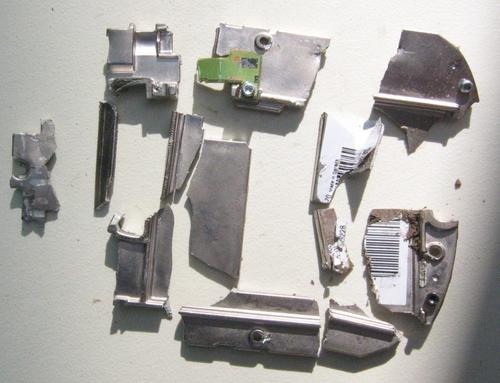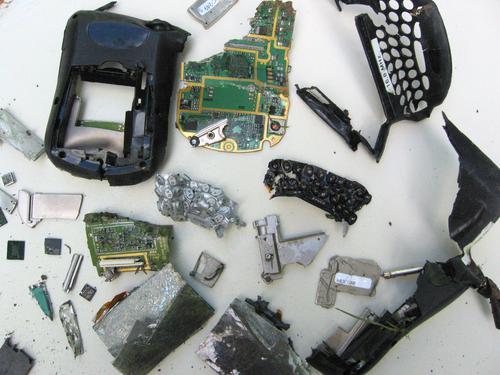3" caliber refined 'Product Launcher' Cannon
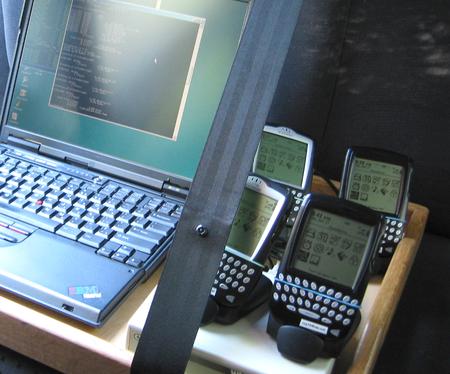 With the popularity of the "product launching"
event in 2003, I organized another event for June 2005.
I built an improved version of my "product launcher" cannon for the occasion.
With the popularity of the "product launching"
event in 2003, I organized another event for June 2005.
I built an improved version of my "product launcher" cannon for the occasion.
The new BlackBerry® prototypes were just a tiny bit narrower than the previous model, so they could now fit in a 3-inch caliber barrel.
The photo at left is the best I could find in my photos of that product after many years. The photos is of a drive test data-logging set-up in the back of my car.
There were a few weaknesses in my 4-inch cannon that I wanted to address:
• The 4" barrel eventually split open.
• The 2" cleanout plug on the back could not withstand the pressure of firing.
• I wanted a combustion chamber bigger than the barrel.
Design and Construction
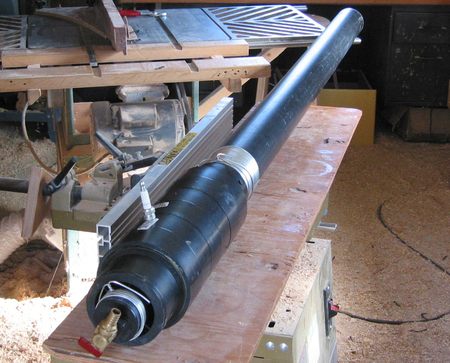 For extra strength, I made the new combustion chamber out
of very short pieces of 4" ABS pipe, joined together with connecting
pieces. The connecting piece fits around the pipe, so effectively,
the combustion chamber has double thickness walls.
There are some weak spots lengthwise between the
connectors, but the 'hoop stress' (around the circumference) of a
pressure cylinder is always twice the lengthwise stress,
so it should be ok. (This difference in hoop vs
axial stress is why pipes always crack along their length, not
around their circumference).
For extra strength, I made the new combustion chamber out
of very short pieces of 4" ABS pipe, joined together with connecting
pieces. The connecting piece fits around the pipe, so effectively,
the combustion chamber has double thickness walls.
There are some weak spots lengthwise between the
connectors, but the 'hoop stress' (around the circumference) of a
pressure cylinder is always twice the lengthwise stress,
so it should be ok. (This difference in hoop vs
axial stress is why pipes always crack along their length, not
around their circumference).
I figured a smaller 1.5" cleanout plug should be able to withstand more pressure than the 2" plug I used previously, so I used a 4" to 3" adapter, and then a 3" to 1.5" adapter, and then a 1.5" screw plug. A 4" to 1.5" adapter would have been better, but I couldn't find one.
I wrapped some steel wire around the part that the plug threaded into to hopefully prevent that from expanding during firing and letting go of the 1.5" plug. I also wrapped the wire around the end of the 3" barrel near the combustion chamber. I figured the part nearest the combustion chamber would be most vulnerable. Further from the chamber, the gas will already have expanded a fair bit before it gets there, so there would be less pressure.

As an extra measure, I made a hardwood bracket to fit around the breech. This was designed to provide even support against the cannon's recoil, especially against the 1.5" plug.
Testing
As with my previous cannon, I used a mixture of about 80% oxygen and 20% MPS gas for fuel. That mixture proved to be quite potent with my previous cannon.I tested the cannon by firing a full coke can out of the barrel. A can of coke is much heavier than a BlackBerry, so if the cannon could withstand that, it should be ok for the BlackBerry.
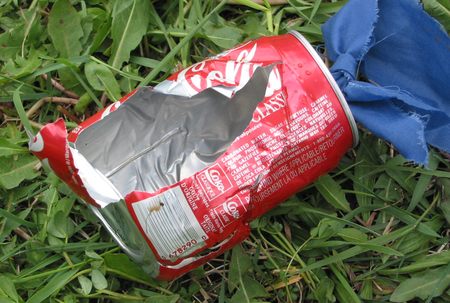 The coke can didn't hold up too well. The bottom of the can
burst open from the acceleration. What was left of the can
expanded to the full 3" diameter of the cannon.
Out of the cannon came a spray of coke, and an empty shredded can, which didn't
fly very far. But the remains of the can fit snugly in the 3" barrel. The top of
the can was undamaged, not even the pop tab had opened.
The coke can didn't hold up too well. The bottom of the can
burst open from the acceleration. What was left of the can
expanded to the full 3" diameter of the cannon.
Out of the cannon came a spray of coke, and an empty shredded can, which didn't
fly very far. But the remains of the can fit snugly in the 3" barrel. The top of
the can was undamaged, not even the pop tab had opened.
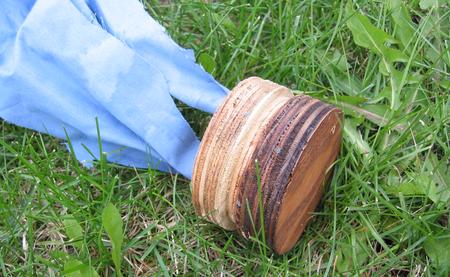 The wooden plug which I used to get a good seal behind the can held
up quite well.
The twisted cloth seal in the plug's groove must have worked fairly well,
because only the part of the plug behind the seal was blackened from
the firing. The blue cloth extending from the plug is intended as a bit
of a drag chute, and to act as a marker to make the plug easier to find.
The wooden plug which I used to get a good seal behind the can held
up quite well.
The twisted cloth seal in the plug's groove must have worked fairly well,
because only the part of the plug behind the seal was blackened from
the firing. The blue cloth extending from the plug is intended as a bit
of a drag chute, and to act as a marker to make the plug easier to find.
Launching event
 We started out by shooting BlackBerry devices into the air. Problem with that is that it
makes it hard to find it afterwards.
We started out by shooting BlackBerry devices into the air. Problem with that is that it
makes it hard to find it afterwards.
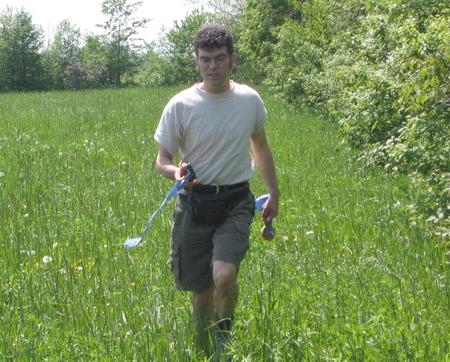 Here's Kent Nickerson, having just found
the BlackBerry and the plug. But we couldn't find all the units we shot,
so somewhere in the field are some damaged BlackBerry handsets.
Here's Kent Nickerson, having just found
the BlackBerry and the plug. But we couldn't find all the units we shot,
so somewhere in the field are some damaged BlackBerry handsets.
Shooting into the air is also kind of inefficient, because most of the kinetic energy is dissipated as aerodynamic drag. And then there's no guarantee the device will even hit anything hard when it lands. It's much better to have the impact close to the cannon, so all the kinetic energy is destructively applied.
 Here you can see the test set-up. The cannon is supported by several pieces of
firewood. Behind the breech is a heavy (12 kg) steel weight to absorb some of the
recoil. At right is a 1" thick steel plate, propped up with some firewood.
For scale, the thin part of the barrel is 1.5m (6') long.
Here you can see the test set-up. The cannon is supported by several pieces of
firewood. Behind the breech is a heavy (12 kg) steel weight to absorb some of the
recoil. At right is a 1" thick steel plate, propped up with some firewood.
For scale, the thin part of the barrel is 1.5m (6') long.
 The results were quite good. The devices ended up in
fragments about the size of a quarter, save for
some of the plastic parts, which can deform a lot without breaking.
The results were quite good. The devices ended up in
fragments about the size of a quarter, save for
some of the plastic parts, which can deform a lot without breaking.
The results are always fascinating!
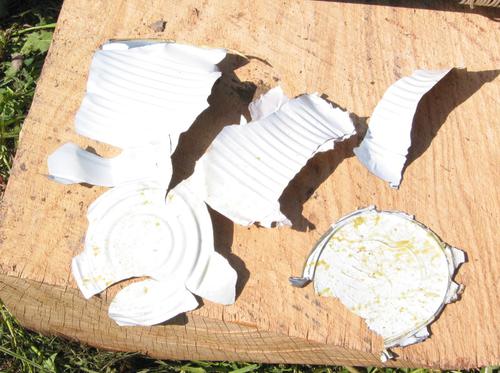 We also fired a few 3" diameter cans of vegetables, which fit
snugly down the barrel. The first can we shot was at a 45
degree angle, and we never found it.
We also fired a few 3" diameter cans of vegetables, which fit
snugly down the barrel. The first can we shot was at a 45
degree angle, and we never found it.
The second vegetable can was shot at the steel plate. I expected this to be quite messy, but with the steel plate angled up slightly, the vegetables were dispersed so finely that we couldn't find a trace of them, except for some small bits of mashed carrot on some fragments of the can. It was also interesting to see the can rip in so many places.
Other findings...
Despite all the countermeasures to keep the 1.5" plug from coming out, it still ended up slipping its threads. This suggests that the MPS gas makes for a much more powerful explosion than the propane or propylene I used on my first cannon, where that same plug held just fine.
This cannon also didn't produce very large fireballs at the muzzle and wasn't as loud as I expected. I'm guessing that most of the energy was used for accelerating the BlackBerry. In fact, on some shots, the sound of the 'ping' against the steel seemed more prominent than the bang from firing the cannon.
Back to the BlackBerry smashing page
